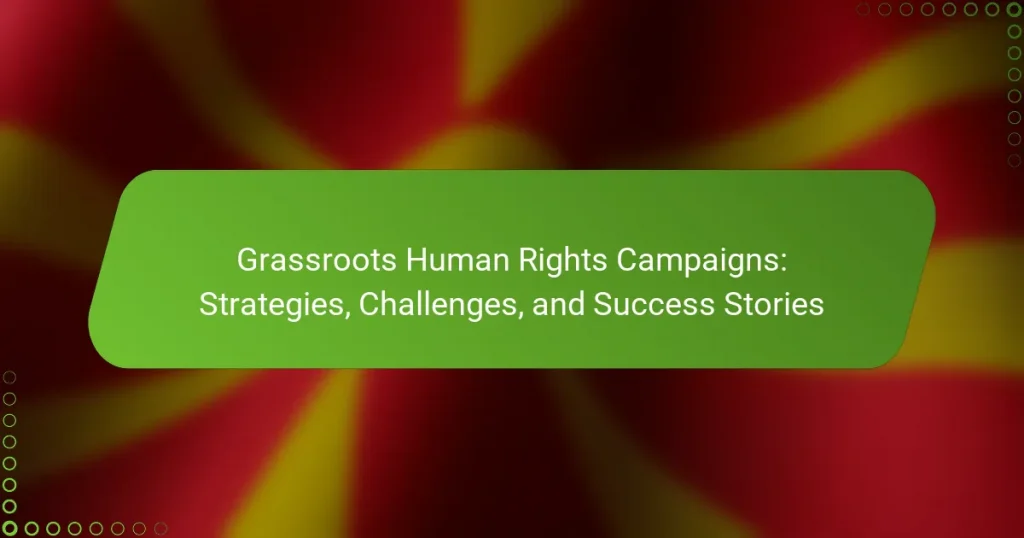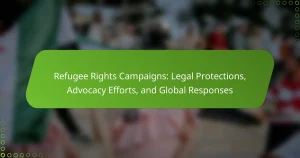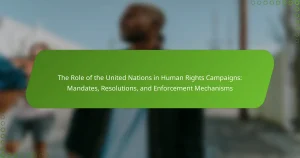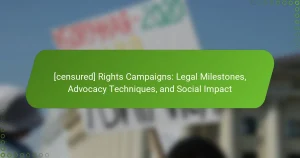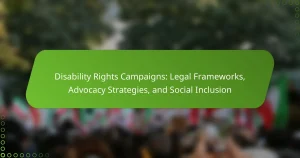Grassroots human rights campaigns are community-driven initiatives focused on promoting and protecting human rights, often emerging from local organizations or individuals advocating for social justice. These campaigns aim to raise awareness about human rights violations and mobilize community support to address issues such as discrimination, violence, and inequality. Strategies employed include protests, social media outreach, and educational programs, with historical examples like the Civil Rights Movement and the #MeToo movement illustrating their effectiveness. The article will explore the strategies, challenges, and success stories of grassroots human rights campaigns, highlighting the importance of local involvement and activism in driving social change. Additionally, it will discuss how individuals can contribute to these initiatives through various actions, reinforcing the collective impact of grassroots movements.
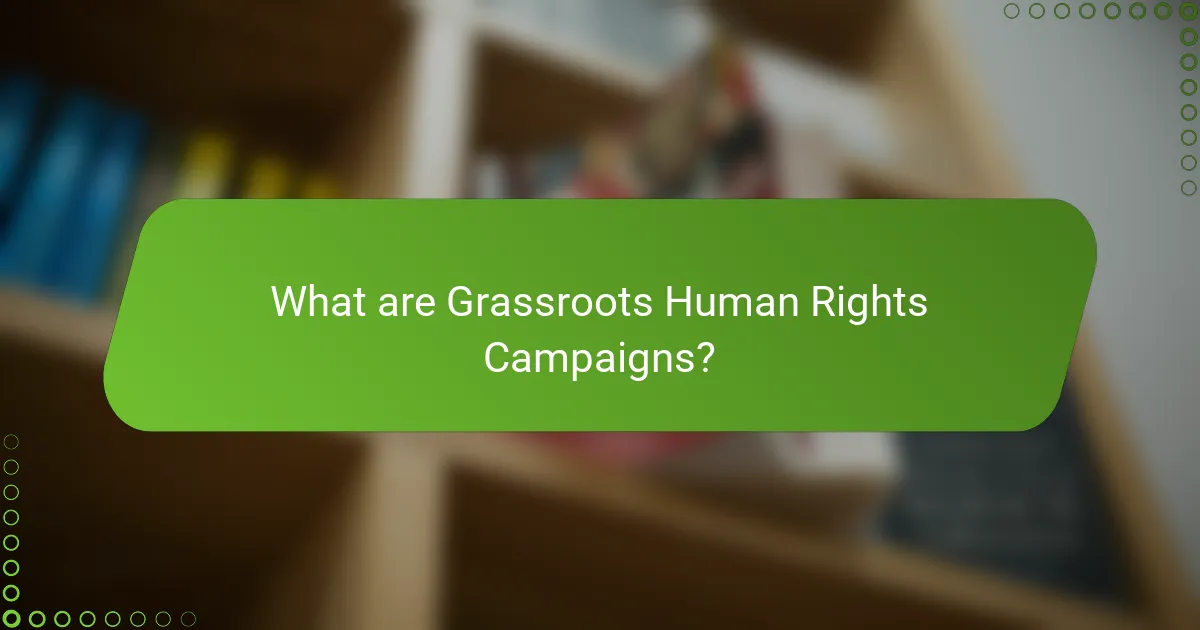
What are Grassroots Human Rights Campaigns?
Grassroots human rights campaigns are community-driven initiatives aimed at promoting and protecting human rights. These campaigns often emerge from local organizations or individuals advocating for social justice. They focus on raising awareness about human rights violations and mobilizing community support. Grassroots campaigns can address issues like discrimination, violence, and inequality. They utilize various strategies, including protests, social media outreach, and educational programs. These campaigns are often characterized by their emphasis on local involvement and grassroots activism. Historical examples include the Civil Rights Movement in the United States and anti-apartheid efforts in South Africa. Such campaigns have proven effective in influencing policy changes and raising public consciousness about human rights issues.
How do Grassroots Human Rights Campaigns differ from traditional campaigns?
Grassroots human rights campaigns differ from traditional campaigns in their approach and structure. Grassroots campaigns prioritize community involvement and local leadership. They often emerge from the needs and experiences of marginalized groups. Traditional campaigns, on the other hand, typically rely on established organizations and top-down strategies.
Grassroots campaigns emphasize direct action and mobilization of individuals. They focus on building relationships within communities. Traditional campaigns may utilize broader media strategies and established networks. Grassroots efforts often leverage social media for rapid organization and outreach. Traditional campaigns may depend on formal funding and institutional support.
Research shows that grassroots campaigns can lead to more sustainable change. For instance, the Black Lives Matter movement illustrates the power of grassroots organizing. It has effectively raised awareness and prompted policy discussions on systemic racism. This demonstrates the unique impact grassroots campaigns can have compared to traditional methods.
What key characteristics define Grassroots Human Rights Campaigns?
Grassroots human rights campaigns are defined by their community-driven nature. They prioritize local involvement and mobilization. These campaigns often focus on specific issues affecting marginalized groups. They utilize grassroots organizing strategies to build support and raise awareness. Direct action and advocacy are common tactics employed. Additionally, they often leverage social media for outreach and engagement. Grassroots campaigns typically emphasize democratic participation and inclusivity. They aim to create sustainable change through community empowerment.
Why are Grassroots Human Rights Campaigns important in today’s society?
Grassroots human rights campaigns are essential in today’s society because they empower local communities to advocate for their rights. These campaigns often address issues that may be overlooked by larger organizations or governments. They create awareness about human rights violations at the community level. Grassroots movements can mobilize individuals to take action, fostering a sense of solidarity and collective responsibility. Research shows that grassroots efforts have led to significant policy changes and social reforms. For instance, the Black Lives Matter movement has highlighted systemic racism and police brutality, prompting national conversations and legislative proposals. Additionally, grassroots campaigns often utilize social media to amplify their messages and reach wider audiences quickly. This accessibility allows diverse voices to participate in the human rights discourse. Overall, grassroots human rights campaigns play a critical role in promoting justice and equality in society.
What strategies are commonly used in Grassroots Human Rights Campaigns?
Grassroots human rights campaigns commonly use community organizing, advocacy, and education strategies. Community organizing involves mobilizing local individuals to raise awareness and take collective action. Advocacy focuses on influencing policymakers to enact or change laws related to human rights. Education strategies aim to inform the public about human rights issues and empower individuals to advocate for themselves. These strategies often include social media campaigns, public demonstrations, and coalition-building with other organizations. Research shows that grassroots movements can lead to significant policy changes and increased public awareness, as seen in various historical contexts.
How can community engagement enhance the effectiveness of these campaigns?
Community engagement enhances the effectiveness of grassroots human rights campaigns by fostering trust and collaboration. Engaged communities are more likely to participate actively in campaigns. This participation can lead to increased awareness and support for human rights issues. When community members feel invested, they share information within their networks. This organic spread of information amplifies campaign messages. Additionally, community engagement allows for feedback on campaign strategies. It ensures that the campaigns resonate with the needs and values of the community. Research shows that campaigns with strong community ties are more successful in achieving their goals. For example, the “Love Has No Labels” campaign effectively utilized community involvement to promote diversity and inclusion.
What role does social media play in promoting Grassroots Human Rights Campaigns?
Social media plays a crucial role in promoting grassroots human rights campaigns. It enables rapid information dissemination to a wide audience. Campaigns can mobilize support and raise awareness effectively. Social media platforms facilitate community building among advocates and supporters. They provide tools for organizing events and protests. Statistics show that campaigns using social media reach more people than traditional methods. For instance, the #MeToo movement gained global traction through social media. This demonstrates its power in amplifying voices and fostering solidarity.
What challenges do Grassroots Human Rights Campaigns face?
Grassroots human rights campaigns face several significant challenges. Limited funding restricts their ability to mobilize resources effectively. Many grassroots organizations rely on small donations and volunteer efforts, which can hinder their reach. Additionally, they often encounter resistance from authorities. This opposition can manifest as legal barriers or even violence against activists.
Another challenge is the lack of visibility. Grassroots campaigns often struggle to gain media attention compared to larger organizations. This can result in insufficient public awareness and support. Furthermore, internal organizational issues can arise. These include disagreements on strategy or mission, which can weaken campaign effectiveness.
Lastly, grassroots campaigns often face difficulties in building sustainable networks. Establishing long-term partnerships can be challenging due to competing interests and limited resources. These factors collectively impede the overall impact of grassroots human rights campaigns.
How do funding limitations impact the success of these campaigns?
Funding limitations severely hinder the success of grassroots human rights campaigns. Insufficient financial resources restrict campaign reach and effectiveness. Limited funds can lead to reduced staffing, impacting campaign organization and execution. Campaigns may struggle to secure necessary materials and tools for advocacy. This can affect outreach efforts, reducing public engagement and awareness. Consequently, campaigns may fail to achieve their objectives and desired impact. Studies show that campaigns with adequate funding are more likely to succeed in influencing policy changes. For instance, the 2018 Global Fund for Human Rights reported that well-funded initiatives had a 30% higher success rate in achieving their goals.
What are the common obstacles in mobilizing community support?
Common obstacles in mobilizing community support include lack of awareness, differing priorities, and resource limitations. Many community members may not understand the cause or its significance. This lack of awareness can lead to apathy or resistance. Differing priorities among community members can hinder collective action. Individuals may focus on personal or local issues rather than broader human rights concerns. Resource limitations, such as funding and volunteer availability, also pose significant challenges. Without adequate resources, campaigns struggle to reach and engage the community effectively. Additionally, distrust in organizations or leaders can create barriers to participation. Studies show that these factors can significantly impede grassroots efforts.
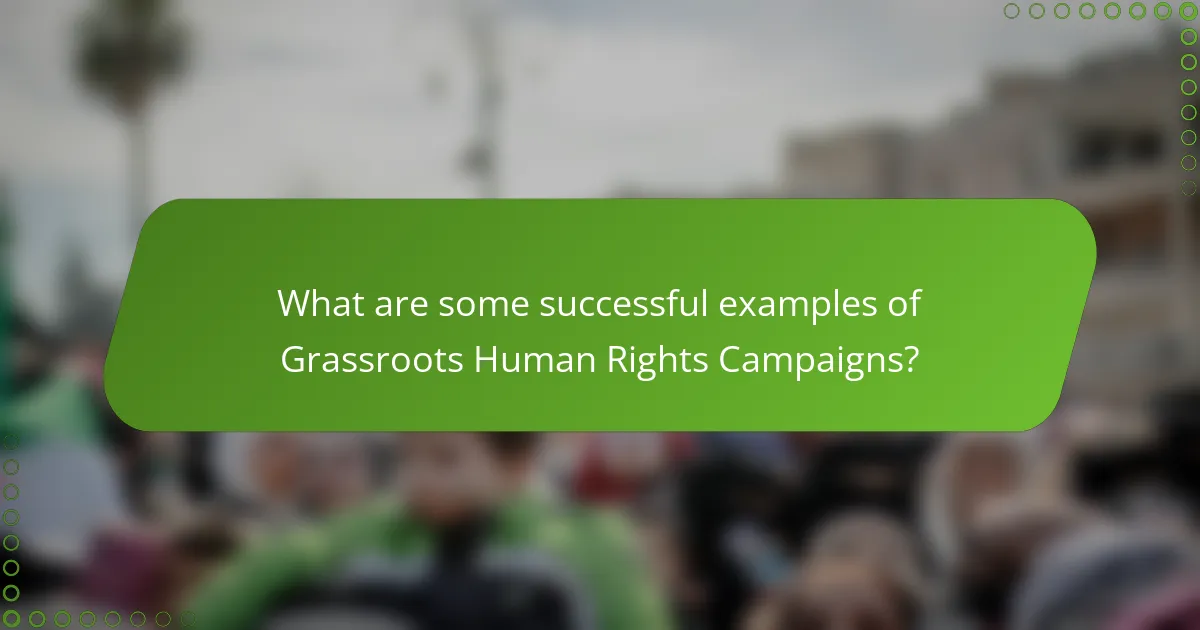
What are some successful examples of Grassroots Human Rights Campaigns?
Successful examples of grassroots human rights campaigns include the Civil Rights Movement in the United States and the #MeToo movement. The Civil Rights Movement fought against racial segregation and discrimination. It led to significant legislative changes, such as the Civil Rights Act of 1964. Activists like Martin Luther King Jr. played pivotal roles in organizing protests and advocating for equality. The #MeToo movement raised awareness about [censured] harassment and assault. It empowered individuals to share their stories and demand accountability. This movement has influenced policies and workplace cultures globally. Both campaigns demonstrate the power of grassroots organizing in effecting social change.
How have specific campaigns achieved significant milestones?
Specific campaigns have achieved significant milestones through strategic grassroots mobilization and community engagement. For example, the “Black Lives Matter” movement successfully raised awareness about racial injustice. It utilized social media to amplify its message and mobilize supporters. Campaigns often leverage partnerships with local organizations to enhance their impact. This collaboration helps to build trust and foster community involvement. Additionally, significant milestones are often marked by legislative changes or public policy reforms. The “Me Too” movement led to increased accountability for [censured] harassment in various sectors. These milestones demonstrate the effectiveness of grassroots efforts in driving social change.
What strategies contributed to the success of these campaigns?
Successful grassroots human rights campaigns often utilize community engagement strategies. These campaigns mobilize local populations to raise awareness and advocate for change. Effective storytelling helps to humanize issues and connect with broader audiences. Social media platforms amplify messages and reach diverse demographics quickly. Collaboration with local organizations enhances credibility and resource sharing. Targeted messaging addresses specific community concerns, making campaigns more relatable. Grassroots fundraising strategies ensure financial sustainability and independence from larger organizations. These strategies collectively empower communities and drive impactful change.
What lessons can be learned from these success stories?
Success stories from grassroots human rights campaigns highlight the importance of community engagement. Effective campaigns often mobilize local populations to raise awareness and drive change. They demonstrate the power of storytelling in connecting with broader audiences. Collaboration among diverse groups enhances the campaign’s reach and impact. Consistent messaging reinforces the campaign’s goals and values. Utilizing social media effectively amplifies voices and builds solidarity. Persistence in the face of challenges is crucial for achieving long-term success. These lessons underscore the need for strategic planning and adaptability in grassroots movements.
What are the long-term impacts of successful Grassroots Human Rights Campaigns?
Successful grassroots human rights campaigns lead to significant long-term impacts on society. They often result in policy changes that enhance legal protections for marginalized groups. For example, the Civil Rights Movement in the United States led to the Civil Rights Act of 1964, which outlawed discrimination based on race. Such campaigns also foster increased civic engagement and awareness among communities. They empower individuals to advocate for their rights and the rights of others. Research shows that sustained activism can change public perception and cultural norms regarding human rights issues. Additionally, successful campaigns often inspire similar movements globally, creating a ripple effect of advocacy. These impacts contribute to a more just and equitable society over time.
How do these campaigns influence policy changes?
Grassroots human rights campaigns influence policy changes by mobilizing public support and raising awareness. These campaigns often highlight injustices and advocate for specific reforms. They utilize social media and community organizing to engage citizens. Increased public pressure can compel policymakers to respond to constituents’ demands. For example, the Civil Rights Movement led to landmark legislation like the Civil Rights Act of 1964. Research shows that grassroots efforts can significantly impact legislative agendas. A study by the Harvard Kennedy School found that public mobilization directly correlates with policy shifts in human rights.
What effects do they have on community awareness and engagement?
Grassroots human rights campaigns significantly enhance community awareness and engagement. They educate local populations about rights issues through workshops and outreach programs. This education fosters informed discussions among community members. Increased awareness leads to heightened interest in local advocacy efforts. Engaged communities are more likely to participate in campaigns and initiatives. Research shows that grassroots movements can mobilize thousands of individuals for social change. For instance, the Human Rights Campaign reported a 30% increase in community participation following targeted advocacy efforts. Such campaigns create a sense of solidarity and shared purpose within communities.

How can individuals contribute to Grassroots Human Rights Campaigns?
Individuals can contribute to grassroots human rights campaigns by volunteering their time and skills. Engaging in community organizing helps raise awareness about human rights issues. Individuals can also donate to support campaign initiatives and resources. Sharing information on social media amplifies the campaign’s reach. Attending local events fosters community solidarity and mobilization. Signing petitions can demonstrate public support for specific human rights causes. Advocating for policy changes at local or national levels influences decision-makers. Collectively, these actions strengthen grassroots movements and drive meaningful change.
What actions can individuals take to support these campaigns?
Individuals can support grassroots human rights campaigns by volunteering their time and skills. Engaging in local events raises awareness and mobilizes community support. Donating to organizations amplifies their resources and outreach capabilities. Sharing campaign messages on social media increases visibility and encourages wider participation. Signing petitions demonstrates collective action and can influence policy changes. Attending rallies or demonstrations shows solidarity with the cause. Educating oneself and others about human rights issues fosters informed advocacy. Collaborating with local groups strengthens the movement and builds networks of support.
How can volunteering enhance the effectiveness of Grassroots Human Rights Campaigns?
Volunteering enhances the effectiveness of grassroots human rights campaigns by increasing community engagement. Active volunteers often bring diverse skills that strengthen campaign strategies. Their involvement can amplify outreach efforts, allowing campaigns to reach broader audiences. Volunteers also provide essential manpower for organizing events and mobilizing supporters. Research shows that campaigns with strong volunteer participation often see increased visibility and impact. For example, the American Civil Liberties Union (ACLU) has effectively utilized volunteers to expand its advocacy efforts. This collaborative approach fosters a sense of ownership within the community, leading to sustained support for human rights initiatives.
What are some effective ways to raise awareness within the community?
Effective ways to raise awareness within the community include organizing local events and workshops. These activities engage community members directly and provide informative content. Social media campaigns can amplify messages to wider audiences quickly. Collaborating with local influencers increases credibility and reach. Distributing flyers and brochures in high-traffic areas ensures visibility. Hosting informational sessions at community centers fosters dialogue and education. Partnering with schools can involve youth and families in awareness efforts. Surveys indicate that face-to-face interactions significantly enhance community engagement.
What best practices should be followed when starting a Grassroots Human Rights Campaign?
Identify a clear mission and objectives for the campaign. This provides direction and focus. Engage with the community to understand their needs and concerns. Building trust and rapport is essential for grassroots efforts. Assemble a diverse team of volunteers and advocates. A range of perspectives strengthens the campaign. Develop a strategic plan outlining actions and timelines. This ensures organized progress towards goals. Utilize social media and local events for outreach. These platforms amplify the campaign’s message effectively. Monitor and evaluate progress regularly. Adjust strategies based on feedback and outcomes. Empower community members to take leadership roles. This fosters ownership and sustainability of the campaign.
How can clear goals and objectives be established for a campaign?
Clear goals and objectives for a campaign can be established by following a structured approach. First, define the campaign’s purpose and desired outcomes. This ensures alignment with overall mission and vision. Next, use the SMART criteria: goals should be Specific, Measurable, Achievable, Relevant, and Time-bound. For example, instead of a vague goal like “raise awareness,” specify “increase social media engagement by 30% within three months.” Involve stakeholders in the goal-setting process to ensure inclusivity and buy-in. Regularly review and adjust goals based on feedback and changing circumstances. This adaptive approach helps maintain relevance and effectiveness in achieving campaign objectives.
What strategies ensure sustained engagement and support from the community?
Effective strategies for sustained engagement and support from the community include fostering open communication and building trust. Regular updates and transparent discussions about campaign goals help maintain interest. Involving community members in decision-making enhances their sense of ownership. Organizing events and activities encourages participation and strengthens relationships. Providing opportunities for feedback allows community members to feel valued. Recognizing and celebrating contributions fosters a positive environment. Research shows that grassroots campaigns with high community involvement see increased support and retention rates. For instance, a study by the Stanford Social Innovation Review highlights that grassroots movements with strong community ties are more successful in achieving their objectives.
Grassroots human rights campaigns are community-driven initiatives aimed at promoting and protecting human rights through local advocacy and mobilization. This article explores the characteristics, strategies, and significance of these campaigns, highlighting their differences from traditional approaches and their impact on policy changes and community awareness. Key challenges faced by grassroots movements, such as funding limitations and mobilizing support, are discussed alongside successful historical examples like the Civil Rights Movement and the #MeToo movement. Additionally, the article outlines effective practices for engaging communities and sustaining support, emphasizing the role of social media in amplifying campaign messages.
